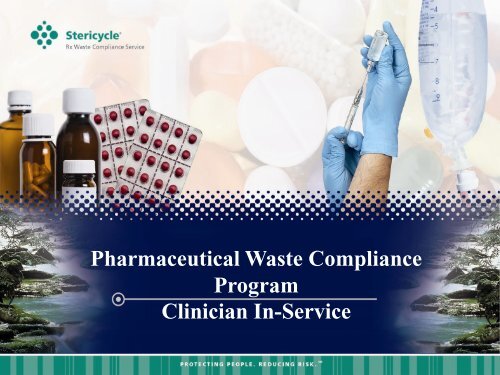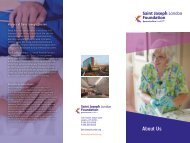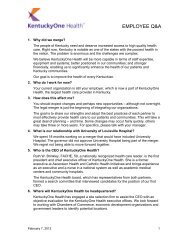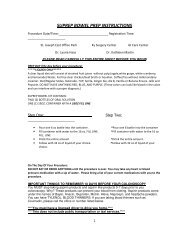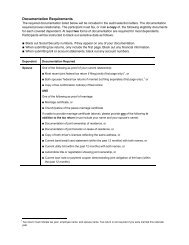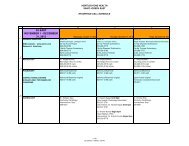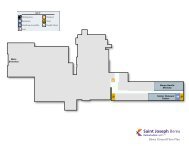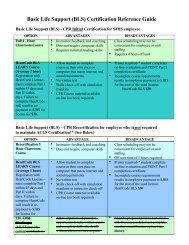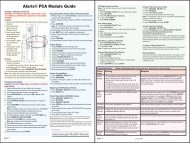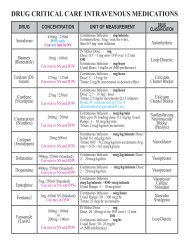Pharmaceutical Waste Compliance Program Clinician In-Service
Pharmaceutical Waste Compliance Program Clinician In-Service
Pharmaceutical Waste Compliance Program Clinician In-Service
You also want an ePaper? Increase the reach of your titles
YUMPU automatically turns print PDFs into web optimized ePapers that Google loves.
<strong>Pharmaceutical</strong> <strong>Waste</strong> <strong>Compliance</strong><br />
<strong>Program</strong><br />
<strong>Clinician</strong> <strong>In</strong>-<strong>Service</strong>
<strong>Pharmaceutical</strong> <strong>Waste</strong><br />
Why Do We Care About It?<br />
•To comply with Federal, State and Local laws & regulations<br />
•To comply with The Joint Commission standards<br />
•To protect patients & staff<br />
•To protect the environment<br />
(2002 Notional Geological Society<br />
Water Study)
Regulatory Requirements<br />
Agencies involved in Rx waste regulation:<br />
• Environment Protection Agency (EPA)<br />
‣Resource Conservation and Recovery Act 1976 (RCRA)<br />
• Department of Transportation (DOT)<br />
• Drug Enforcement Agency (DEA)<br />
• Publicly Owned Treatment Works (POTW)<br />
• The Joint Commission (TJC)
Common EPA <strong>In</strong>spection Violations<br />
• Hazardous waste determinations not done or incorrect<br />
• Labeling of hazardous waste not done or incorrect<br />
• Throwing HW down the drain<br />
• Improper disposal of chemotherapy drugs<br />
• <strong>In</strong>adequate training for employees in HW management<br />
• Not conducting proper weekly inspections of HW storage<br />
• No or inadequate HW manifests<br />
• Improper management of expired pharmaceuticals<br />
• Lack of emergency contingency plan<br />
“Identification and Management of Regulated<br />
Hazardous <strong>Waste</strong>” – EPA Region 2
TJC Accreditation Issues<br />
• MM.01.01.03 - Medication Management<br />
• The organization safely manages high-alert and hazardous<br />
medications.<br />
• EC.02.02.01 - Environment of Care<br />
• The organization manages risks related to hazardous materials and<br />
wastes.<br />
• EM.02.02.05, EP 4 – Emergency Management<br />
• The organization prepares for how it will manage hazardous materials<br />
and waste.<br />
• LD.04.01.01 - Leadership<br />
• The organization complies with law & regulation.<br />
TJC Standards <strong>In</strong>formation<br />
http://www.jointcommission.org/
Regulatory Summary<br />
<strong>Pharmaceutical</strong> waste is a regulatory concern<br />
<strong>Pharmaceutical</strong>s are included in EPA/RCRA hazardous waste<br />
regulations<br />
Regulatory oversight by EPA, DOT & POTW<br />
EPA enforcement activities at hospital level<br />
‣ As high as $360,000<br />
The Joint Commission under their elements of performance<br />
require proper management of hazardous materials including<br />
pharmaceutical waste (Standard EC.02.02.01, EP8)
What is <strong>Pharmaceutical</strong> <strong>Waste</strong>?<br />
<strong>Pharmaceutical</strong> waste is a drug that is:<br />
No longer used for its intended purpose<br />
To be discarded
Forms of <strong>Pharmaceutical</strong> <strong>Waste</strong><br />
Forms of <strong>Pharmaceutical</strong> <strong>Waste</strong> in Patient Care Areas:<br />
Partial vials<br />
Partial IVs<br />
Partial syringes<br />
Discontinued medicines<br />
Unadministered medicines<br />
Patient prescriptions
When and Where is <strong>Pharmaceutical</strong> <strong>Waste</strong><br />
Generated?<br />
When the decision is made to discard an Rx product, it<br />
is no longer usable for intended purpose.<br />
Wherever pharmaceuticals are prepared, used or<br />
dispensed to patients.<br />
Hospital Pharmacies (30%)<br />
<strong>In</strong>patient and Out-Patient Care Areas (70%)
Hazardous Versus Non-Hazardous<br />
<strong>Pharmaceutical</strong> <strong>Waste</strong><br />
EPA Resource Conservation & Recovery Act (RCRA), 1976<br />
Characteristic Hazardous <strong>Waste</strong><br />
Toxic, corrosive, reactive or ignitable<br />
Commercial Chemical (Listed) Hazardous <strong>Waste</strong><br />
P Listed - Acutely Hazardous<br />
U Listed - Toxic (Chemo)<br />
• Non-RCRA <strong>Waste</strong><br />
No characteristic and/or not Listed
Examples of <strong>Pharmaceutical</strong> <strong>Waste</strong><br />
<strong>Pharmaceutical</strong> <strong>Waste</strong><br />
• Partial vials (safety caps<br />
removed)<br />
• Un-dispensed,<br />
pre-instilled IV’s<br />
• Hospital repacks<br />
• Pre-filled syringes<br />
• Partial syringes<br />
• Discontinued meds<br />
• Un-administered meds<br />
• Patient prescriptions<br />
• Physician RX samples<br />
Characteristic Hazardous<br />
• Lantus<br />
• Humalog<br />
• Humulin N&R<br />
• Novalog<br />
• Flovent<br />
• Taxol<br />
P – Listed<br />
• Nicotine<br />
• Coumadin/Warfarin<br />
U – Listed<br />
• Chemotherapy drugs<br />
• Cytoxan<br />
• Mutamycin<br />
* State Specific<br />
Non - Compatible<br />
• Qvar<br />
• Hydroxyzine HCL<br />
• Silver Nitrate<br />
Non-compatible waste<br />
is a type of waste that<br />
can not be mixed with<br />
other pharmaceuticals<br />
due to the reactive<br />
nature of the chemical<br />
compounds found in<br />
each one. This material<br />
is either flammable,<br />
corrosive, or an<br />
oxidizer.
Compatible Versus Non-Compatible<br />
<strong>Pharmaceutical</strong> <strong>Waste</strong><br />
Two categories of hazardous pharmaceutical waste<br />
identified by EPA:<br />
Compatible – Rx waste that CAN be placed in the<br />
same container without danger of a chemical<br />
reaction<br />
Non-Compatible – Rx waste that CANNOT be placed<br />
in the same container with other Rx waste because<br />
it may cause a dangerous chemical reaction<br />
• Corrosives: Hydroxyzine HCL<br />
• Oxidizers: Silver Nitrate<br />
• Flammable: Qvar
EPA RCRA Trace, Empty and Bulk<br />
Trace<br />
• Used to describe empty hazardous (RCRA) waste<br />
containers<br />
RCRA Empty - Both conditions must be met:<br />
• All contents removed via commonly employed<br />
practices (pouring, pumping, aspirating)<br />
• Less than 3% of original weight by capacity if the<br />
container is less than or equal to 110 gal<br />
Bulk<br />
• More than “trace”
<strong>Pharmaceutical</strong> <strong>Waste</strong> <strong>Service</strong>s<br />
Stericycle <strong>Pharmaceutical</strong> <strong>Waste</strong><br />
<strong>Compliance</strong> <strong>Program</strong>
Here Is Our Solution<br />
1. Identification of waste<br />
2. Education<br />
3. Segregation of waste<br />
4. Transportation and Destruction of waste
Healthcare <strong>Waste</strong> Streams<br />
These waste streams stay the same.<br />
Trace Chemo<br />
EMPTY<br />
ITEMS<br />
Controlled Substances<br />
Bulk Chemo<br />
Plain and Empty<br />
What is different? <strong>Pharmaceutical</strong> <strong>Waste</strong><br />
Only when there is medication left in a vial, syringe, ampoule or IV bag,<br />
pills and capsules included<br />
Non-RCRA<br />
Rx <strong>Waste</strong><br />
(Non-Haz)<br />
Compatible<br />
Hazardous<br />
Non Compatible<br />
90+/- % 7+/- % 1+/- %
What Does Not Change<br />
• Controlled Substances – Follow your hospital’s written<br />
policy.<br />
• Empty Items – Empty IVs, vials and syringes will<br />
continue to be disposed of according to current<br />
procedures.<br />
• Sugar/Salt water IVs – Can still go down the drain:<br />
saline, glucose, potassium, dextrose, electrolytes, and<br />
lactated ringer’s. (No Medications <strong>In</strong>stilled)
RX <strong>Waste</strong> Flow<br />
Non-Hazardous<br />
RX WASTE<br />
Compatible Hazardous<br />
7+/- %<br />
Non-Compatibles/<strong>In</strong>halers<br />
1+/-%<br />
90+/- % of RX <strong>Waste</strong><br />
Compatible<br />
Hazardous<br />
Black Container<br />
Return to Pharmacy<br />
Aerosols & <strong>In</strong>halers<br />
Oxidizers/Corrosives<br />
RMW Area- DOT Packed<br />
CAA – DOT Packed<br />
CAA – DOT Packed<br />
* Non-compatible containers placed in high use areas.
<strong>Service</strong> Model<br />
• Satellite accumulation of color coded Rx waste containers<br />
must be “at or near” the point of generation (EPA) under<br />
control of the generator<br />
• Transfer of Rx waste containers to central hazardous waste<br />
storage area by Stericycle Technicians (Environmental<br />
<strong>Service</strong>s are Back-up).<br />
• Hazardous and Non - RCRA waste: Trained Stericycle Field personnel<br />
will over pack hazardous pharmaceutical and Non- RCRA waste into proper DOT<br />
disposal containers by DOT defined waste stream.
Satellite Accumulation<br />
Locations containers are placed to capture waste:<br />
Pharmacy<br />
Oncology - Chemo<br />
All Other Patient Care Areas<br />
‣ Medication Dispense Station<br />
‣ Med Carts (OR)<br />
‣ Med Rooms<br />
‣ Soiled Utility Room
Satellite Accumulation Containers<br />
Color-Coded Containers<br />
• Non - Hazardous <strong>Waste</strong> (Blue)<br />
• Compatible Hazardous (Black)<br />
• 2 Gallon Black Sharps
<strong>Waste</strong> Sort Codes<br />
• Sort codes will be:<br />
‣ Utilized with several methods to emphasize proper segregation of hazardous drugs<br />
‣ Used for approximately 200 hazardous drugs<br />
• Non-coded items go into the BLUE non-RCRA containers<br />
•Items coded go into the appropriate BLACK container:<br />
•Hazardous Compatible (BKC)<br />
•Acutely Hazardous (PBKC)<br />
•Non-Compatible (SP)
What Drug Goes Where?<br />
Sort codes can be utilized in several ways to emphasize proper segregation of<br />
hazardous drugs. Sort codes will be used for the approximate 200 hazardous<br />
drugs. Non-coded items go into the BLUE non-RCRA container.<br />
• Rx Patient Label<br />
<strong>Waste</strong> Code Options<br />
• Dispensing machine (I.E. Pyxis and Omni dose)<br />
• Cubies marked in (Pyxis) medication dispenser<br />
• Patient Record Sheet (MAR)<br />
• Zip lock bag out/ zip lock back to pharmacy<br />
• Container Posters<br />
• Medi-Tech Machines<br />
Note: Remember this is for hazardous, acutely hazardous, and non compatible<br />
drugs only
Non-RCRA Rx <strong>Waste</strong><br />
• What Goes <strong>In</strong> the Non-Hazardous Reusable BLUE Container<br />
‣ Partial IVs (place in zip lock bag)<br />
‣ Tubing attached to IV<br />
‣ Unused Pills and capsules<br />
‣ Partial Vials<br />
‣Sponges soaked in liquid meds<br />
(place in zip lock bag)<br />
‣ Topical ointments (capped)<br />
What Does Not Go <strong>In</strong> the Container<br />
‣No Sharps (Needles or Syringes [with or without a needle])<br />
‣ No Controlled Substances<br />
8 gallon<br />
Approximately 90+/- %of All Rx <strong>Waste</strong> Will Go <strong>In</strong>to This Container
2 Gallon Black Sharps Container<br />
• What Goes <strong>In</strong> the Black 2 Gallon Sharps<br />
Container<br />
– Syringes and ampoules with medication<br />
(hazardous or non-hazardous) left over<br />
(partial, unused) that are not considered a<br />
controlled substance.<br />
2 gallon<br />
OR<br />
A<br />
N<br />
D
Compatible and Non-Compatible Hazardous<br />
<strong>Waste</strong> Container<br />
Compatible Hazardous (BKC)<br />
• Majority of hazardous waste<br />
*P-Listed will be coded as (PBKC)<br />
Patient Care Units (SP) (SPC) (SPO)<br />
Aerosols/<strong>In</strong>halers and any waste from<br />
Non-compatibles will be sent back to Pharmacy<br />
8 gallon<br />
Non-Compatible hazardous waste Containers can be placed in areas that generate a copious<br />
amount of this waste.
RX <strong>Waste</strong> <strong>Compliance</strong> <strong>Program</strong><br />
Questions


